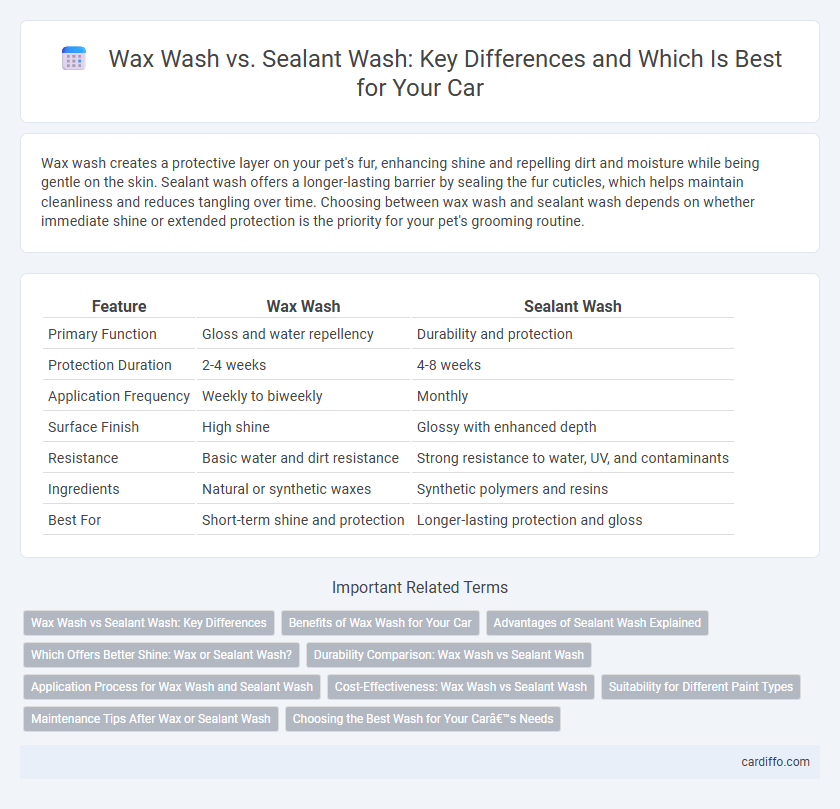Wax wash creates a protective layer on your pet's fur, enhancing shine and repelling dirt and moisture while being gentle on the skin. Sealant wash offers a longer-lasting barrier by sealing the fur cuticles, which helps maintain cleanliness and reduces tangling over time. Choosing between wax wash and sealant wash depends on whether immediate shine or extended protection is the priority for your pet's grooming routine.
Table of Comparison
| Feature | Wax Wash | Sealant Wash |
|---|---|---|
| Primary Function | Gloss and water repellency | Durability and protection |
| Protection Duration | 2-4 weeks | 4-8 weeks |
| Application Frequency | Weekly to biweekly | Monthly |
| Surface Finish | High shine | Glossy with enhanced depth |
| Resistance | Basic water and dirt resistance | Strong resistance to water, UV, and contaminants |
| Ingredients | Natural or synthetic waxes | Synthetic polymers and resins |
| Best For | Short-term shine and protection | Longer-lasting protection and gloss |
Wax Wash vs Sealant Wash: Key Differences
Wax wash enhances paint protection by adding a layer of natural carnauba wax, providing a deep gloss and hydrophobic finish that repels water and contaminants. Sealant wash uses synthetic polymers designed for durability and long-lasting protection, offering superior resistance against UV rays, oxidation, and environmental pollutants. Choosing between wax wash and sealant wash depends on preference for organic shine versus extended durability and stronger environmental defense.
Benefits of Wax Wash for Your Car
Wax wash protects the car's paint by creating a hydrophobic barrier that repels water, dirt, and contaminants, reducing the risk of corrosion and staining. It enhances the vehicle's shine and depth, maintaining a glossy finish that lasts longer compared to sealant wash. Regular use of wax wash improves the car's overall appearance and can extend the lifespan of the paintwork by providing a natural, protective layer.
Advantages of Sealant Wash Explained
Sealant wash provides a protective barrier that extends the durability of your vehicle's paint by repelling dirt, water, and contaminants more effectively than wax wash. Its advanced polymer technology bonds to the surface, offering longer-lasting shine and enhanced resistance against environmental damage. This makes sealant wash a superior option for maintaining a clean, glossy finish with less frequent washing compared to traditional wax wash.
Which Offers Better Shine: Wax or Sealant Wash?
Wax wash provides a deeper, warmer shine by infusing car paint with natural oils and polymers that enhance gloss and depth. Sealant wash delivers a more reflective, high-gloss finish through synthetic polymers designed for durability and water beading. For optimal shine, wax wash appeals to those seeking richness and warmth, while sealant wash suits those prioritizing long-lasting, mirror-like gloss.
Durability Comparison: Wax Wash vs Sealant Wash
Wax wash typically offers shorter durability, lasting around 2 to 4 weeks due to its organic compounds breaking down faster under environmental exposure. Sealant wash, composed of synthetic polymers, provides extended protection lasting up to 4 to 6 months by forming a more resilient and hydrophobic layer on the surface. The enhanced durability of sealant wash makes it more suitable for long-term protection against contaminants and UV damage.
Application Process for Wax Wash and Sealant Wash
Wax wash involves applying a thin layer of carnauba or synthetic wax onto a clean vehicle surface using a foam applicator, followed by a brief drying period before buffing it off with a microfiber towel to enhance shine and protection. Sealant wash relies on applying a polymer-based sealant directly onto the paint, allowing it to bond and cure for a longer-lasting protective barrier, typically requiring less frequent reapplication than wax. Both processes emphasize thorough surface preparation and even application to maximize durability and aesthetic benefits on automotive paint.
Cost-Effectiveness: Wax Wash vs Sealant Wash
Wax washes typically cost more upfront due to premium wax products offering deeper protection and gloss, while sealant washes often provide a more budget-friendly option with longer-lasting durability. Sealants create a hard, synthetic barrier that can last several months, reducing the frequency of washes compared to wax, which wears off faster and requires more frequent applications. Evaluating the balance between initial cost and maintenance frequency positions sealant washes as generally more cost-effective over time for vehicle paint protection.
Suitability for Different Paint Types
Wax wash is ideal for older or oxidized paint finishes, offering protective wax layers that enhance shine and hide minor imperfections, making it suitable for softer, porous paints. Sealant wash provides a longer-lasting protective barrier with synthetic polymers that resist environmental contaminants, perfect for newer or clear-coated paints requiring durable protection. Selecting between wax and sealant wash depends on the paint's condition and type, ensuring optimal care and longevity of the vehicle's finish.
Maintenance Tips After Wax or Sealant Wash
After a wax wash, regularly apply a microfiber drying towel to prevent water spots and preserve the protective layer's longevity; avoid harsh detergents that can strip away the wax. Sealant wash maintenance requires using pH-balanced car shampoos to maintain the sealant's durability and reapply sealant every 4 to 6 months for optimal protection. Consistent washing using gentle techniques ensures the vehicle's paint remains glossy and safeguarded from environmental contaminants.
Choosing the Best Wash for Your Car’s Needs
Wax wash enhances your car's shine and adds a protective layer that repels water and dirt, making it ideal for preserving paint gloss. Sealant wash offers longer-lasting protection by bonding to the paint surface, providing durability against environmental contaminants. Selecting the best wash depends on your preference for immediate shine versus extended protection and the frequency of your car washes.
Wax Wash vs Sealant Wash Infographic

 cardiffo.com
cardiffo.com